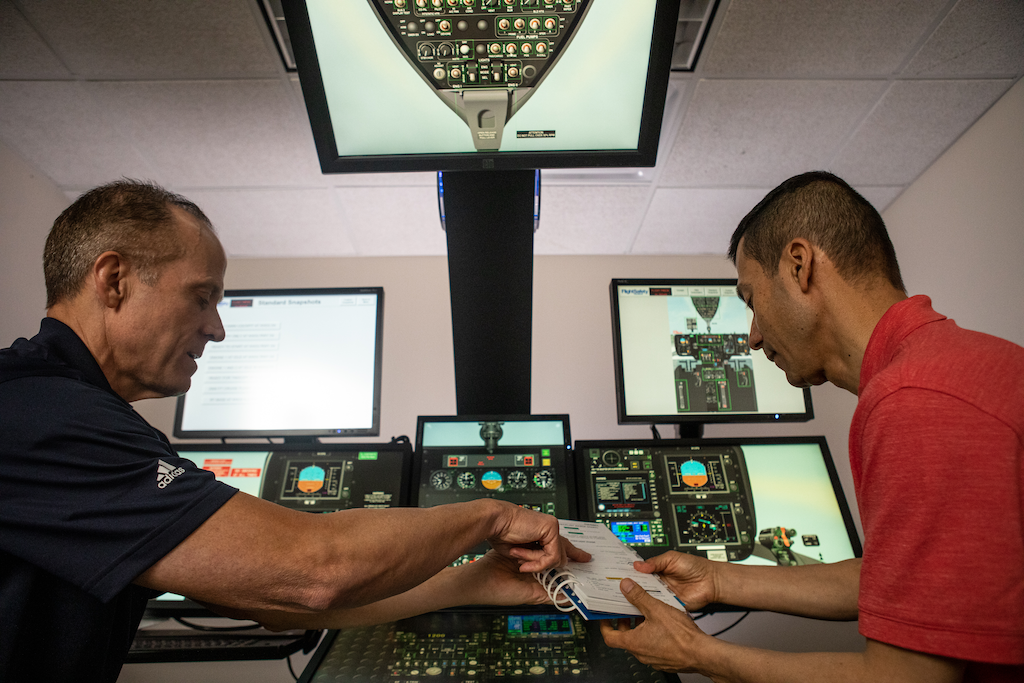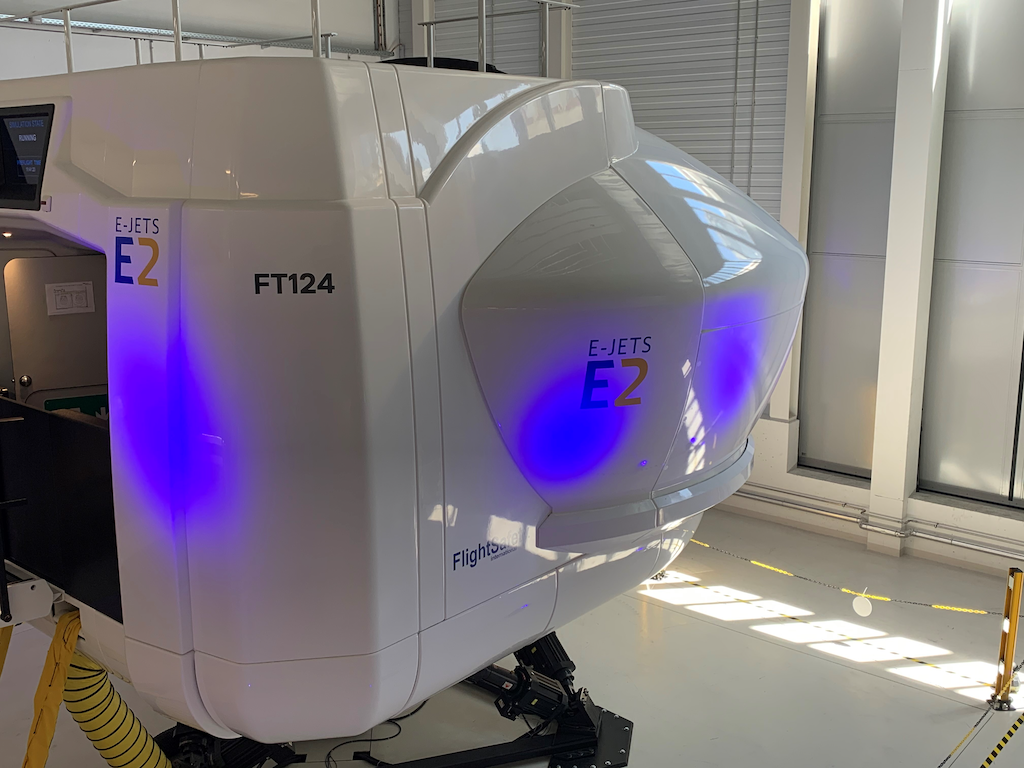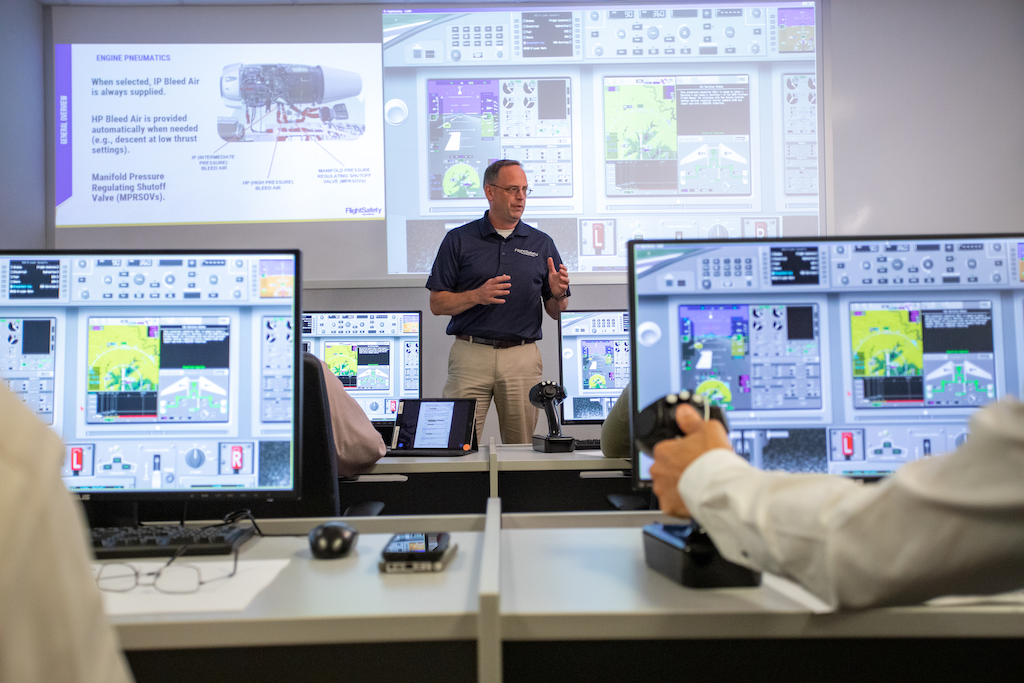How Advances in Pilot Training Have Aided Crossover Narrowbody Jet Pilots

One of aviation’s well-known phrases (some might say clichés) is that one of the best safety devices in an aircraft is a well-trained pilot. And the task of training pilots advances continuously.
When new aircraft types come along, however, there is an additional opportunity for airlines, training organizations and training technology providers to put new ideas – by they hardware or software – into practice.
The introduction of crossover narrowbody jets in the latter part of the 2010s was just such an opportunity. With a clean sheet aircraft in the Airbus A220-100/300 pair and an almost clean sheet type in the E-Jets E2 family, stakeholders all took a look at their areas of expertise.
Michael Vercio, senior vice-president of simulation systems at FlightSafety International, enthusiastically explains the collaboration and development that takes place on such occasions. “Working on simulators for new aircraft is always exciting. First and foremost, FlightSafety gets to interface with some of the newest technologies from all the OEMs,” he remarks.

Credit: Helvetic Airlines
“We start the planning process early in the aircraft’s development and work closely with the aircraft manufacturer to develop a simulator that, in some cases, acts as a testbed for aircraft crews during the certification process. The simulator provides clues into handling characteristics and human factors analysis while the aircraft certification progresses. Once the aircraft is certified for operation, the simulator is ready for use,” Vercio reports.
“FlightSafety uses a variety of tools to teach systems proficiency,” he continues. “Students start by learning the aircraft systems and familiarity on desktop devices in the classroom. These interactive software packages allow students to become familiar with switch locations, system schematics, and finally, learn the avionics and FMS (flight management system) packages.”
After the classroom work, according to Vercio, students move on to FlightSafety’s Graphical Flight Simulator (GFS) for a more cockpit-style training device. “The GFS allows the user to carry out virtually all the functions that would be performed in the aircraft. System schematics and flows are illustrated through animated graphics, so the student sees first-hand how the aircraft performs via cockpit switch inputs,” he elaborates. “An instructor operating station with the same appearance provides control of the GFS, just as on our full-flight simulators (FFSs). Finally, the student is ready to maximize their training input in the FFS.
The SVP adds that in parallel to simulator design and testing, FlightSafety’s courseware team develops a training curriculum needed to ensure students become proficient in an aircraft’s systems and are well versed in executing the necessary training requirements. “Whether it’s pilot or maintenance training, virtual reality is being integrated into the student’s curriculum. Whether it’s a virtual pre-flight of a Pilatus or virtually boroscoping an engine, these new technologies allow students to perform things in the classroom that would otherwise be impossible,” he states.

Credit: FlightSafety International
One airline that is benefitting from new training programmes and technology – as well as Embraer E190-E2s and E195-E2s in its fleet – is Helvetic Airways. The carrier’s head of training, Nicolas Bachmann, details the programmes and devices its pilots have been experiencing i their E2 training.
“Besides the availability of a FFS in Opfikon, Switzerland, at LAT (Lufthansa Aviation Training), we’ve received a modern FTD which has been integrated into Type Rating training. The FTD is mainly used for procedure training and in combination with theoretical aircraft knowledge training,” he comments. “The advantage of an interactive lecture on aircraft systems results in the longer retention of knowledge by students. Additionally, it provides the opportunity to focus solely on each system and its working conditions in normal and abnormal situations.
“Due to the modern FFS and FTD and their close location to our headquarters, we are able to optimize our processes in the administrative and organizational aspects of training. The combination of theoretical training, for example in the morning, followed by a practical lesson in the FFS or FTD in the afternoon, largely improves the learning effect and efficiency of the training,” Bachmann declares.
Having looked at the features that have been introduced for the pilot training programmes for the new types, there has also been the chance to put new technologies into full slight simulators to enhance the training there.
“At this time, we’ve introduced two new features in our FFS training, both being possible because of the modern FFS equipment,” Bachmann reports. “One is the In-Seat-Instruction station (ISI) which allows the instructor to demonstrate an exercise in either pilot seat while simultaneously being able to operate the simulator console. This tablet-sized control station has all the same functions available as the instructor has when sitting at the operator control station in the FFS.
“Furthermore, a modern de-briefing station is available and currently being configured for its optimum use,” the Helvetic executive adds. “This feature will allow the instructor to record events during the session and to use them for specific de-briefing techniques. As mentioned, this feature is already available but is currently in the final stage of being configured to our needs. Besides having video recording of CRM (crew resource management)-related issues in the simulator, the recordings also include all fight control deflections, flight path, automation state and further relevant items.”
To further enhance its E2 training, the airline is in the project stage of developing a web-based flight management system (FMS). “This will enable future pilots to train the FMS and its various functions. This Helvetic-specific programming of the FMS will allow company specific items to be included and to simulate line flying activities (LOFT – Line Oriented Flight Training) as realistically as possible,” Bachmann explains.
As for the new technologies that FlightSafety has introduce into the FFS to enhance pilot training on crossover jets, Michael Vercio has plenty to relate. “For airlines with large pilot pools, the focus is on maximizing the amount of training an organization can do on existing devices. As discussed above, maximizing the students’ time in an FFS is key to good operations. FlightSafety has several technologies to maximize these experiences.
“One technology utilized is a debriefing tool called SimVu. This is a proprietary technology that allows instructors to replay all phases of a student’s flight in the simulator and analyze the performance for safety and technique,” he says. “This technology shows students first-hand what their subliminal flight techniques are and where to improve their techniques for safety and proficiency. This includes small, but important, irregularities that may have been missed during a flight.”
Vercio also points out that along with developing technology which enhances training in the FFS, FlightSafety is also improving the technology which monitors the device itself to ensure availability. “Just like an airplane, when a simulator goes AOG, customer time is lost and revenue slips. In the coming months, FlightSafety will roll out next-generation diagnostic capabilities that will improve troubleshooting, reduce downtime, and save customers’ time and costs. With many training operations running 24/7, keeping a simulator operational is just as important as keeping an airplane in the air,” the SVP declares.
Where possible, of course, much of the new training ingredients brought in for the A220 and E-Jets E2 families will be put to use in training for other aircraft types. Meanwhile, those investing in these new types are getting training efficiencies to go along the operational efficiencies of their aircraft.





